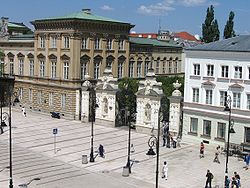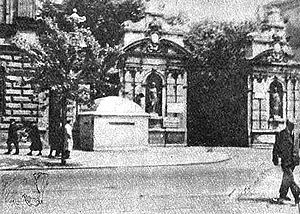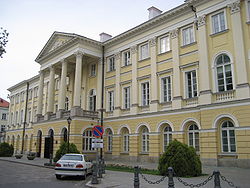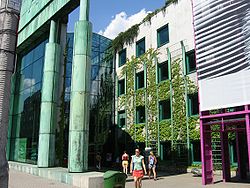| University of Warsaw |
| Uniwersytet Warszawski |

Warsaw University gate on Krakowskie Przedmieście |
| 拉丁语: Universitas Varsoviensis |
| 建立于 |
November 19, 1816 |
| 类型 |
Public |
| 捐赠 |
PLN 376,442,402 (approx. USD 132'000'000) |
| Rector |
Professor Katarzyna Chałasińska-Macukow |
| 工作人员 |
5,531 |
| 学生 |
56,858 (November 2005) |
| Doctoral students |
2,148 |
| 位置 |
Warsaw, Poland |
| 校园 |
Urban |
| 归属 |
EUA, Socrates-Erasmus |
| 网址 |
www.uw.edu.pl |
The University of Warsaw (Polish: Uniwersytet Warszawski) is the largest and most prestigious university in Poland, ranked by the Times Higher Education Supplement as the first/second best Polish university among the world top 500 in 2006.
历史
1816-31
The Royal University of Warsaw was established in 1816, when the partitions of Poland separated Warsaw from the oldest and most influential Polish academic center, in Kraków. The first to be established in Congress Poland were the Law School and the Medical School. In 1816 Tsar Alexander I permitted the Polish authorities to create a university, comprising five departments: Law and Administration, Medicine, Philosophy, Theology, and Art and Humanities. The university soon grew to 800 students and 50 professors.
After most of the students and professors took part in the November 1830 Uprising the university was closed down.
1857-69
After the Crimean War, Russia entered a brief period of liberalization, the "Post-Sevastopol Thaw." Permission was given to create a Polish medical and surgical college (Akademia Medyko-Chirurgiczna) in Warsaw. In 1862 departments of Law and Administration, Philology and History, and Mathematics and Physics were opened. The newly-established college gained importance and was soon renamed the "Main School" (Szkoła Główna). However, after the January 1863 Uprising the liberal period ended and all Polish-language schools were closed again. During its short existence, the Main School educated over 3,000 students, many of whom became the backbone of Polish intelligentsia.
1870-1915
The Main School was replaced with a Russian-language "Imperial University of Warsaw". Its purpose was to provide education for the Russian military garrison of Warsaw, the majority of students (up to 70% out of an average of 1 500 to 2 000 students) were Poles. The tsarist authorities believed that the Russian university would become a perfect way to Russify Polish society and spent significant a significant sum on building a new university campus. However, various underground organizations soon started to grow and the students became their leaders in Warsaw. Most notable of these groups (the supporters of Polish revival and the socialists) joined the ranks of the 1905 Revolution. Afterwards a boycott of Russian educational facilities was proclaimed and the number of Polish students dropped to below 10%. Most of the students who wanted to continue their education left for Galicia and Western Europe.
After the fall of the January Rising (1863-1864) and the authorities' decision to convert the Main School into a Russian-language university, which functioned under the name of Imperial University for 46 year, there were two times when the question of moving the university into Russia was considered. During the 1905-1907 revolution, such a proposal was made by some of the professors, in the face of a boycott of the university by Polish students. Talks on that subject were conducted with a number of Russian cities, including Voronezh and Saratov. The Russian government finally decided to keep a university in Warsaw, but as a result of the boycott, the university was Russian not only in the sense of the language used, but also of the nationality of its professors and students.
For the second time the question emerged during the First World War, when the military and political situation forced the Russian authorities to evacuate. Beginning from the autumn of 1915, there were two Universities of Warsaw: one Polish, in Warsaw, and another Russian, in Rostov-on-Don which functioned until 1917. On 5 May 1917 the Russian Provisional Government decided to close the University of Warsaw. The decision took effect on 1 July 1917; on the same day, the University of the Don, now called Rostov State University (Southern Federal University since 2006), was inaugurated.
1915-18
During the World War I Warsaw was seized by Germany in 1915. In order to win the Poles for their case and secure the Polish area behind the front lines the governments of Germany and Austria-Hungary allowed for a certain liberalization of life in Poland. In accordance with the concept of Mitteleuropa, German military authorities permitted several Polish social and educational societies to be recreated. One of these was Warsaw University. The Polish language was reintroduced, and the professors were allowed to return to work. In order not to let the Polish patriotic movement out of control the number of lecturers was kept low (usually not more than 50), but there were no limits on the number of students. Until 1918 their number rose from a mere 1,000 to over 4,500.
1918-39
After Poland regained its independence in 1918, the University of Warsaw began to grow very quickly. It was reformed; all the important posts (the rector, senate, deans and councils) became democratically elected, and the state spent considerable amounts of money to modernize and equip it. Many professors returned from exile and cooperated in the effort. By the late 1920s the level of education in Warsaw had reached that of western Europe.
By the beginning of the 1930s the University of Warsaw had become the largest university in Poland, with over 250 lecturers and 10,000 students. However, the financial problems of the newly-reborn state did not allow for free education, and students had to pay a tuition fee for their studies (an average monthly salary for a year). Also, the number of scholarships was very limited, and only approximately 3% of students were able to get one. Despite these economic problems, the University of Warsaw grew rapidly. New departments were opened, and the main campus was expanded.
After the death of Józef Piłsudski the senate of the University of Warsaw changed its name to "Józef Piłsudski University of Warsaw" (Uniwersytet Warszawski im. Józefa Piłsudskiego). A time of troubles began for academics in Poland as rightist students proceeded to organize anti-Semitic demonstrations and riots - the Sanacja government reacted to limit the autonomy of the universities. The government was forced to back down in 1937 and the right-wing followers of the nationalist parties were peacefully pacified, but professors and students remained divided for the rest of the 1930s as the system of segregated seating for Jewish students, known as ghetto benches, was implemented customarily, not institutionally, which should be noted. There was no such legal institution as backed such discriminatory deeds in Poland. Rather, it can be said that there was no legal institution to clearly ban such deeds there despite Pilsudski’s pursuit of the Jagiellonian Ideology that is to establish equal multi-ethnic Poland to resume the principle of the Polish-Lithuanian Commonwealth's Constitution of May 3, 1791, which was rather a technical matter. The case of discrimination against the social minority can be compared to the era before the Civil Rights Movement in the United States.
1939-44
- For more details on this period see: Underground Education in Poland During World War II

Main gate of the university in July 1944, when it was converted to a German military barracks
After the Polish Defensive War of 1939 the German authorities of the General Gouvernment closed all the institutions of higher education in Poland. The equipment and most of the laboratories were taken to Germany and divided amongst the German universities while the main campus of the University of Warsaw was turned into military barracks.
German racist theories assumed that no education of Poles was needed and the whole nation was to be turned into uneducated serfs of the German race. Education in Polish was banned and punished with death. However, many professors organized the so-called "Secret University of Warsaw" (Tajny Uniwersytet Warszawski). The lectures were held in small groups in private apartments and the attendants were constantly risking discovery and death. However, the net of underground faculties spread rapidly and by 1944 there were more than 300 lecturers and 3,500 students at various courses.
Most of the students took part in the Warsaw Uprising as the soldiers of Armia Krajowa and Szare Szeregi. The German-held campus of the University was turned into a well-fortified area with bunkers and machine gun nests. Also, it was located close to the buildings occupied by the German garrison of Warsaw. Heavy fights for the campus started on the first day of the Uprising, but the partisans were not able to break through the fortified gates. Several assaults were bloodily repelled and the campus remained in German hands until the end of the fights.
During the uprising and the occupation 63 professors were killed, either during fights or as an effect of German policy of extermination of Polish inteligentsia. The University lost 60% of its buildings during the fighting in 1944. Up to 80% of the collections (including priceless works of art and books donated to the University) were either destroyed or transported to Germany, never to return.
1945-56
After World War II it was not clear whether the university would be restored or whether Warsaw itself would be rebuilt. However, many professors who had survived the war returned to Poland and began organizing the university from scratch. In December 1945, lectures resumed for almost 4,000 students in the ruins of the campus, and the buildings were gradually rebuilt. The lost collections were compensated with several former German collections from territories awarded to Poland, among them large parts of the library of count Schaffgotsch, the biggest private library of Germany, the library of the Gymnasium Carolineum in Nysa, three libraries in Legnica (among them the Bibliotheka Rudolphina) and several smaller collections from Walbrzych, Zagan, Staniszow, Zlotoryja, Luban, Ksiaz, Olesnicka, Kaliningrad, Szczecin, Stargard Szczecinski and Markowo. Until the late 1940s the university remained relatively independent. However, soon the communist authorities of Poland started to impose controls and the period of Stalinism started. Many professors were arrested by the Urząd Bezpieczeństwa (Secret Police), the books were censored and ideological criteria in employment of new lecturers and admission of students were introduced. On the other hand, education in Poland became free of charge and the number of young people to receive the state scholarships reached 60% of all the students.
1956-89
|
|
This article needs additional citations for verification.
Please help improve this article by adding reliable references. Unsourced material may be challenged and removed. (March 2007) |

Kazimierz Palace, rectorate of Warsaw University.
After Władysław Gomułka rose to power in Poland in 1956 a brief period of liberalization ensued, though communist ideology still played a major role in most faculties (especially in such faculties as history, law, economics and political science). International cooperation was resumed and the level of education rose, but the government soon started to suppress freedom of thought, which led to increasing unrest among the students. An anti-Semitic and anti-democratic campaign in 1968 led to an outbreak of student demonstrations in Warsaw, which were brutally crushed by the police and militia groups of ordinary workers. As a result, a large number of students and professors were expelled from the university, while some were drafted into the army. Most professors of Jewish descent were forced to emigrate, while the leaders of the democratic movement, Jacek Kuroń and Karol Modzelewski, were sentenced to 3.5 years in prison.
Nevertheless, the University remained the centre of free thought and education. What professors could not say during lectures, they expressed during informal meetings with their students. Many of them became leaders and members of the Solidarity movement and other societies of the democratic opposition. The scientists working at the University of Warsaw were also among the most prominent printers of books forbidden by censorship.
校园

Entrance to new Warsaw University Library on Dobra street.
The main campus of the University of Warsaw is in downtown Warsaw, in Krakowskie Przedmieście. It comprises several historic palaces, most of which had been nationalized in the 19th century. The chief buildings include:
- Kazimierzowski Palace (Pałac Kazimierzowski) - the seat of the rector and the senate;
- the Old Library (Stary BUW) - since recent refurbishment, a secondary lecture building;
- the Main School (Szkoła Główna) - former seat of the Main School until the January 1863 Uprising, later the faculty of biology; now, since its refurbishment, the seat of the institute of archaeology;
- Auditorium Maximum - the main lecture hall, with seats for several hundred students.
There is also the New Library (Nowy BUW) - an impressive new building with spectacular roof gardens as well as several smaller campuses elsewhere in the city, most notably the physical and chemical center in Banacha Street (ulica Banacha), where the Department of Mathematics, Computer Science and Mechanics (MIM) is located.
The University of Warsaw owns a total of 126 buildings. Further construction and a vigorous renovation program are underway at the main campus.
 |
This section requires expansion. |
Departments
- Applied Linguistics and East-Slavonic Philology [3]
- Applied Social Sciences and Resocialization
- Biology [4]
- Chemistry [5]
- Economic Sciences [6]
- Education
- Geography and Regional Studies [7]
- Geology [8]
- History [9]
- Journalism and Political Science
- Law and Administration [10]
- Management [11]
- Mathematics, Informatics, and Mechanics [12]
- Modern Languages
- Oriental Studies [13]
- Philosophy and Sociology [14]
- Physics [15]
- Polish Studies
- Psychology [16] (Polish) and [17] (English)
Other institutes
- American Studies Center
- British Studies Centre
- Centre de Civilisation Francaise et d'Etudes Francophones aupres de l`Universite de Varsovie
- Centre for Archaeological Research at Novae
- Centre for Environmental Study
- Centre for Europe
- Centre for European Regional and Local Studies (EUROREG) [18]
- Centre for Foreign Language Teaching
- Centre for Inter-Faculty Individual Studies in the Humanities [19]
- Centre for 拉丁语-American Studies (CESLA)
- Centre for Open Multimedia Education
- Centre for the Study of Classical Tradition in Poland and East-Central Europe
- Centre of Studies in Territorial Self-Government and Local Development
- Chaire UNESCO du Developpement Durable de l`Universite de Vaersovie
- Comite Polonais de l`Alliance Francais
- Erasmus of Rotterdam Chair
- Heavy Ion Laboratory
- Individual Inter-faculty Studies in Mathematics and Natural Sciences [20]
- Institute of Americas and Europe
- Institute of International Relations - host of GMAPIR
- The Robert B.Zajonc Institute for Social Studies [21]
- Inter-faculty Study Programme in Environmental Protection
- Interdisciplinary Centre for Behavioural Genetics
- Interdisciplinary Centre for Mathematical and Computational Modelling [22]
- Physical Education and Sports Centre
- Polish Centre of Mediterranean Archaeology
- University Centre for Technology Transfer
- University College of English Language Teacher Education
- University College of French Language Teacher Education
- University College of German Language Teacher Education
- University of Warsaw for Foreign Language Teacher Training and European Education
Institutions
- Academic Radio Kampus [23]
- Institute of Information Science and Book Studies [24]
- The Institute of Polish Language and Culture 'Polonicum' [25]
- University of Warsaw Libraries [26]
Notable alumni
- Jerzy Andrzejewski (1909-1983), author
- Krzysztof Kamil Baczyński (1921-1944), poet
- Menachem Begin (1913-1992), Zionist, prime minister of Israel, Nobel Peace Prize winner
- Tadeusz Borowski (1922-1951), poet and writer
- Kazimierz Brandys (1916-2000), writer
- Marian Brandys (1912-1998), writer and journalist
- Fryderyk Chopin (1810-1849), pianist and composer
- Włodzimierz Cimoszewicz (b. 1950), politician, former Prime Minister of Poland
- Adam Doboszyński (1904-1949), politician and writer
- Joseph Epstein (1911-1944), communist leader of French resistance
- Bronisław Geremek (1932-2008), historian and politician
- Witold Gombrowicz (1904-1969), writer
- Jan T. Gross (b. 1947), historian and writer, Princeton University professor
- Gustaw Herling-Grudziński (1919-2000), journalist, writer and GULag survivor
- Leonid Hurwicz (1917-2008), Nobel Prize in Economics winner
- Czesław Janczarski (1911-1971), poet and Russian literature translator
- Lech Kaczyński (1949-2010), right-wing politician, former president of Warsaw, former 校长 of Poland
- Aleksander Kamiński (1903-1978), writer and one of the leaders of the Polish Scouting
- Ryszard Kapuściński (1932-2007), writer and journalist
- Mieczysław Karłowicz (1876-1909), composer
- Jan Karski (1914-2000), Polish resistance fighter
- Alpha Oumar Konaré, (b. 1946), Malian president
- Janusz Korwin-Mikke (b. 1942), right-wing, conservative-liberal politician and journalist
- Marek Kotański (1942-2002), psychologist and streetworker
- Jacek Kuroń (1934-2004), historian, author, social worker and politician
- Jan Józef Lipski (1926-1991), literature historian, politician
- Jerzy Łojek (1932-1986), historian and writer
- Tadeusz Mazowiecki (b. 1927), author, social worker, journalist, former Prime Minister of Poland
- Ludmiła Marjańska (b. 1923), poet and English literature translator
- Adam Michnik (b. 1946), journalist
- Karol Modzelewski (b. 1937), historian and politician
- Jan Olszewski (b. 1930), lawyer and politician, former Prime Minister of Poland
- Janusz Onyszkiewicz (b. 1937), politician
- Bolesław Piasecki (1915-1979), extreme right-wing politician
- Bohdan Paczyński (1940-2007), astronomer
- Longin Pastusiak (b.1935), politician
- Andrew Paulukiewichz (1958) Microbiologist
- Krzysztof Piesiewicz (b. 1945), lawyer and screenwriter
- Bolesław Prus (1847-1912), writer
- Józef Rotblat (1908-2005), physicist, Nobel Peace Prize winner
- Stanisław Sedlaczek (1892-1941), social worker and one of the leaders of Związek Harcerstwa Polskiego
- Yitzhak Shamir (b. 1915) Prime Minister of Israel
- Dmitry Strelnikoff (b. 1969), Russian writer, biologist and a journalist for television, radio and the press
- Alfred Tarski (1902-1982), logician and mathematician
- Julian Tuwim (1894-1953), poet and writer
- Alfred Twardecki (b. 1962), archaeologist, historian of antiquity, museologist
- Janusz Andrzej Zajdel (1938-1985), physicist and science-fiction writer
- Anna Zawadzka (1919-2004), social worker and one of the leaders of Związek Harcerstwa Polskiego
- Maciej Zembaty (b. 1944), poet and writer, famous for his grim humour and translations of Leonard Cohen's works
- Janusz Zeyland (1896-1944), medician and pneumonia specialist, one of BCG inventors
- Rafał A. Ziemkiewicz (b. 1964), writer
- Florian Znaniecki (1882-1958), philosopher and sociologist
Notable professors
- Osman Achmatowicz (1899-1988), chemist, rector of the Technical University of Łódź (1946-1953)
- Szymon Askenazy, historian
- Karol Borsuk (1905-1982), mathematician
- Cezaria Anna Baudouin de Courtenay-Ehrenkreutz-Jędrzejewiczowa (1885-1967), ethnologist and anthropologist, one of the founders of Polish modern ethnology
- Jan Niecisław Baudouin de Courtenay (1845-1929), linguist, inventor of phoneme
- Zygmunt Bauman (b. 1925), sociologist
- Benedykt Dybowski (1833-1930), biologist and explorer of Siberia and Baikal area
- Michel Foucault, French philosopher, at the University dean-faculty of the French Centre 1958-1959
- Aleksander Gieysztor (1916-1999), historian
- Stanisław Grabski (1871-1949), economist
- Henryk Greniewski (1903-1972), mathematician, informatician and pioneer of computers in Poland
- Henryk Jabłoński (1909-2003), historian, nominal head of state of Poland (1972-1985)
- Feliks Pawel Jarocki (1790 - 1865), zoologist
- Irena Jurgielewiczowa (1903-2003), writer
- Dawid Kulisz (b. 1926), mathematician
- Leszek Kołakowski (1927-2009), philosopher
- Kazimierz Kuratowski (1896-1980), mathematician
- Joachim Lelewel (1786-1861), historian, politician and freedom fighter
- Antoni Leśniowski (1867-1940), surgeon and medic, one of the discoverers of Crohn's disease
- Edward Lipiński (1888-1986), economist, founder of the Main Statistical Office
- Jan Łukasiewicz (1878-1956), mathematician and logician
- Kazimierz Michałowski (1901-1981), archaeologist, explorer of Deir el Bahari and Faras
- Andrzej Mostowski (1913-1975), mathematician
- Maria Ossowska (1896-1974), sociologist
- Stanisław Ossowski (1897-1963), sociologist
- Juliusz Owidzki (1921-1986), actor and radio speaker
- Grigol Peradze (1899-1942), Orthodox theologian
- Leon Petrażycki (1867-1931), jurist, philosopher and logician, one of the founders of sociology of law
- Wlasyslaw Pilars de Pilar - (*Opatowek 1874- +Chorzów 1952), a literature professor at the Warsaw University, poet and entrepreneur
- Adam Podgórecki (1925-1998), sociologist of law
- Henryk Samsonowicz (b. 1930), historian, rector (1980-1982)
- Wacław Sierpiński (1882-1969), mathematician
- Alfred Sokołowski (1849-1924), physician and a pioneer in tuberculosis treatment
- Nikolay Yakovlevich Sonin (1849-1915), mathematician
- Jan Strelau (b. 1931), psychologist
- Jerzy Szacki (b. 1929), sociologist and historian
- Stanisław Thugutt (1873-1941), politician, rector (1919-1920)
- Włodzimierz Zonn (1905-1985), astronomer
更多
- Warsaw school of history
- Warsaw School of Mathematics
参考文献
- ^ Yearly report of the Principal of the University of Warsaw for 2005 [1].
- ^ The University of Warsaw: 'university'? 'of Warsaw'? [2]
External links
 |
Wikimedia Commons has media related to: Warsaw University |
- Official website of the University of Warsaw
- The University's computer network
- The WU Students Association
- Website of The University New Library
|
|



